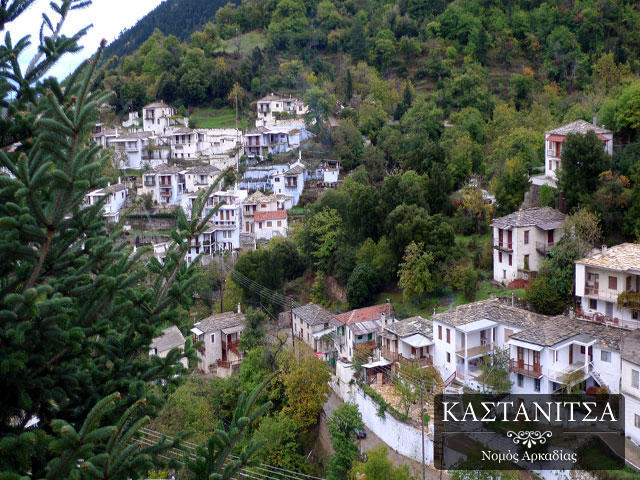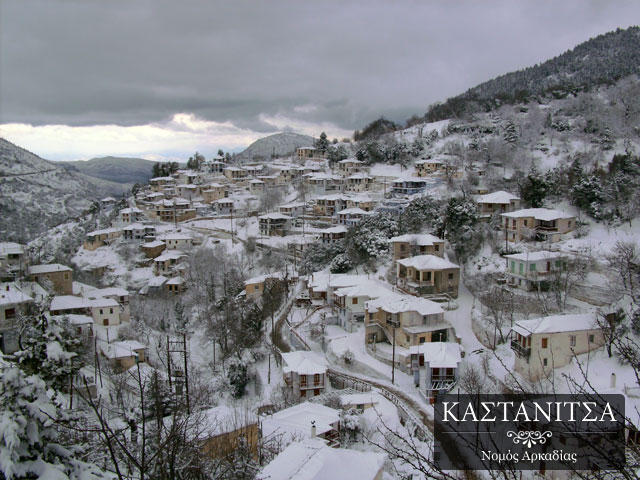Pictures: www.kathimerini.gr, www.kastanitsa.gr
The absolutely white stone village with roofs made of slabs from Malevos, built by the hands of renowned masters from Langada is located at an altitude of 900 metres and resembles a village of the Aegean islands. Kastanitsa is one of the oldest mountain villages of the Kinouria region. It was founded in the 11th century, when peasants from Tsakonia, chased by Frankish conquerors, sought safety here. Over the centuries, they have struggled not only with the new conquerors, the Turks, but also with difficult conditions for survival. For these reasons, many people emigrated and established colonies in Bucharest, Istanbul, Smyrna, and later in America. However, they did not forget their homeland and returned to the village in order to build big houses.

However, why is a mountain village so white? It is no accident - for centuries, the main product of the region has been lime, which was slaked in traditional limekilns. At one time there were more than 40 limekilns here. And now this is still continuing, and therefore houses courtyards and churches are whitewashed.
Chestnuts are another traditional product. Once, they yielded more than 500 tonnes. Today, they yield less, but the chestnuts in the area are known for their excellent quality. You can try them in jams and various dishes, even as a liqueur.
A walk in the village
Kastanitsa is a traditional village. Walking around the village, you will see the famous tower houses with quadrilateral roofs covered with grey limestone slabs, wooden balconies with columns and small windows with white curtains. Many of them are more than 300 years old. While climbing towards the square, you will see the sides of Parnonas (also known as Malevos) covered with fir and chestnut trees. The square is small but picturesque. Residents are few, but particularly hospitable.

At the southern end of the village, on top of a hill, you will find the ruins of the Kapsambelis Tower – a defence tower from the Ottoman rule. From here, you will reach the road leading to the majestic fortress. The view from the top of the castle is magical. On one side Kastanitsa is visible among chestnut trees, and on the other side you will see deep gorges reaching the sea.
Another landmark is the primary school which dates back to 1879. Today, it hosts the Ethnographic Museum. The church of the Transfiguration of Our Lord, built in 1780, is also impressive. There are several chapels around the village the oldest of which is St. Panteleimon.
Routes

A weekend in Kastanitsa means relaxation in the stone guest house of Antoniou, many walks along picturesque streets and through villages in the area, such as Prastos, Tsindzina, Polidroso, Sitana, Platanos, Agios Petros, Vamvakou, Varvitsa, etc. You can also take a walk in the forests along paths connecting villages.
You can visit the historic monastery of Malevi and the Oria fortress by car. The old monastery of Englistourio is also worth seeing which is located on the road to Prastos. You can visit the monastery of St. Nicholas Kondolinas, built in the early 16th century.
If you get tired of the mountains and want a little sea, you can go down to the beach in Agios Andreas, where there is an old stone bridge and a round tower. The Moustou reserve is also nearby.
At night you can enjoy a meal in the small taverns in the square.
The festival of the chestnut

It is celebrated each year on 26 October. Chestnut growers organize a nice festival, during which visitors can learn about and try chestnuts in many variations – boiled or baked, in jams or liqueur, as well as in various dishes. They can also get to know about the cultivation of chestnuts and their nutritional value, as well as the problems of growers.
How to get there
By car, from Athens to Astros, Kinouria (150 km), from there - towards Agios Andreas (another 10 km) and then Kastanitsa (18 km) follows.
Where to stay
Antoniou guest house (phone: 27550 52255-6, 6979 003530, www.sun-mountain-snow.gr). Located in a restored stone building, it has 5 rooms in a rustic design with amenities, and views over the gorge with chestnut trees. Owner Dimitris Antoniou is the soul of the guest house, who will inform you about everything. Breakfast is served in the lounge with a large fireplace, and includes warm slices of bread, jam, honey, sausages, cheeses, as well as many kinds of coffee.

Guest houses in the surrounding villages
Anna (Platanos, phone: 6976 623 099) – a new guest house with 6 rooms with bathrooms, TV, stove, refrigerator and heating.
Foundas (Agios Ioannis, phone: 27550-52022, 6972 021 942) – a stone guest house over the main road, with 5 rooms, each in a different style and a dining room with a large fireplace where coffee is also served.
Sholarhio (Tsindzina, phone:27310-96276, www.tsintzina.gr) – the stone school of the village has been transformed into a guest house.
Malevos (Agios Petros, phone: 27920-31155, 31375, 377 328 6945) – two-storey stone houses, each with a living room, a fireplace, a kitchen, two bathrooms, a TV and a bedroom with a balcony.
Where to eat
Traditional taverns can be found in the square of the village:
• To Stolidi (phone: 6979 003 530), Mrs. Konstantina Antoniou always greets you with a smile; here you can try pork with chestnuts and fried potatoes, a chestnut salad, chickpeas with chestnuts, lamb, as well as eggplant stuffed with onions and cheese in the oven. For dessert, try the pie with chestnuts and walnuts.
• O Parnon (phone: 6976 892 209), good dishes, such as rooster with pasta, eggplants with tomatoes and garlic, grilled chicken and many more.
For coffee and sweets go to Kendrikon cafe.
Shopping
Jams, herbs and spices, legumes, local tsipouro brandy and of course, anything with chestnuts - all this can be found in the shop of Kato tis Anastasias at the beginning of the road leading to the village.